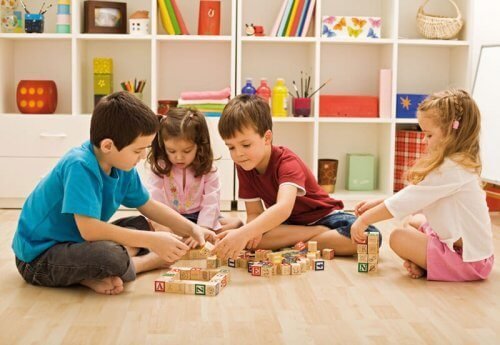Benefits of Educating Children Through Play

Play is an activity that society as a whole tends to overlook. Parents often think that their children are “wasting time” when they’re out playing with their friends. However, nothing could be further from the truth.
The benefits of playing for children
It’s a proven fact that playful activities are an important part of a person’s education. They influence children’s personality, values, and abilities. Therefore, allowing your children to spend several hours a day playing provides the following benefits:
- Playing encourages teamwork and stimulates social relations: Play requires interacting with others. Many team activities also require children to come up with strategies and work together towards a common goal.
- Promotes physical development: As children play, especially when they play outdoors, little ones improve their physical abilities, coordination, etc.
- Improved stimulation: Feeling included and valued as a participant in a game contributes to healthy self-esteem.
- Play allows for learning: Many games require the use of logic in order to come up with desired solutions. This is even true for sports. They help children to understand methods, the laws of physics, the way the human body works, and so much more.
- Tension relief: While this may sound contradictory, this decompression actually contributes to improved school performance. This occurs no matter how much time children take away from studying in order to play. Clearly, in this case, less is more.
- Play teaches children to exercise discipline: Playing requires all participants to follow certain rules.
Tips to educating children through play
Another benefit of using play as a teaching method is that it helps parents learn to collaborate with their children. Games allow children to escape from a constant vertical transmission of knowledge – that is, from a superior to a student. Instead, learning takes place in a dynamic and relaxed setting.
When in a playful context, children are more willing to learn and participate. They’re more open and apply their creativity more effectively. They don’t feel pressured to obtain results. Rather, they’re motivated by the mere satisfaction of winning or reaching their goals.

At home, play can help to establish positive behavior in children. For example, you can conduct “inspections” as if you were a detective. In that playful role, you can “investigate” to see if your children brush their teeth correctly.
In the same way, you can check if their rooms are tidy. Of course, they should receive some sort of reward and acknowledgement that will motivate them to continue with this methodology.
Educating children through play can also help you get them to bathe regularly, for example, if they tend to be reluctant. Playfulness is also a great motivator when it comes to getting ready for school on time without complaining. The sky’s the limit!
The secret lies in discovering your child’s playful and competitive side. Of course, rather than driving your children to compete against one another, encourage them to learn, improve and develop their skills.
“Games allow children to escape from a constant vertical transmission of knowledge – that is, from a superior to a student. Instead, learning takes place in a dynamic and relaxed setting.”
Types of games
If you’re on board with the idea of educating children through play, the options are endless. Here are a few of our favorite ideas to put into practice with your little learners:
Concentration games
This type of activity puts children’s listening abilities to the test. It also demands the use of their cognitive abilities, including reasoning and concentration.
At the same time, concentration games help develop your children’s physical abilities and imagination. Without a doubt, they’re an excellent way to exercise very important skills.
Indoor games
If weather conditions aren’t allowing you to play outside, there are plenty of indoor options. Whether you’re a teacher or a parent, you can make use of the indoors to educate through play.
Just like concentration games, indoor games require participants to sharpen their senses and put their minds to work.
Many of these games allow children to play collectively. This contributes to the formation of values such as teamwork. If a child has siblings, then a rainy day of creative indoor play will help to strengthen the bond between them.
Physical education games
As the name itself implies, these activities are aimed at improving and developing children’s motor skills. At the same time, they’re an excellent way to strengthen the union between teammates and to improve strategic abilities.
Physical education activities are also ideal for motivating children to overcome their own limits and fears. While physical education doesn’t always get the space it deserves in school curriculums, it’s just as important to child development as any other subject. Research affirms its benefits, which go far beyond mere satisfaction.

Role playing games
While they may seem quite trivial at first glance, role playing games are actually quite an important part of childhood. They represent the first instance in which children face the real world (fictitiously) and play a part in it.
This makes them assume certain “responsibilities” and establish different types of relationships with others. Whether children pretend to be doctors, patients, teachers or students, they’re preparing for the role they’ll play as adults.
Lastly, these games are fundamental to the development of language and imagination. Even when children pretend to be pirates or animals – something they of course won’t be when they grow up – they’re still improving important aspects.
To conclude, the benefits of educating children through play are numerous and cannot be overlooked. In light of this information, underestimating the importance of play is foolish. Having fun and being active is a key part of a child’s healthy development.
Play is an activity that society as a whole tends to overlook. Parents often think that their children are “wasting time” when they’re out playing with their friends. However, nothing could be further from the truth.
The benefits of playing for children
It’s a proven fact that playful activities are an important part of a person’s education. They influence children’s personality, values, and abilities. Therefore, allowing your children to spend several hours a day playing provides the following benefits:
- Playing encourages teamwork and stimulates social relations: Play requires interacting with others. Many team activities also require children to come up with strategies and work together towards a common goal.
- Promotes physical development: As children play, especially when they play outdoors, little ones improve their physical abilities, coordination, etc.
- Improved stimulation: Feeling included and valued as a participant in a game contributes to healthy self-esteem.
- Play allows for learning: Many games require the use of logic in order to come up with desired solutions. This is even true for sports. They help children to understand methods, the laws of physics, the way the human body works, and so much more.
- Tension relief: While this may sound contradictory, this decompression actually contributes to improved school performance. This occurs no matter how much time children take away from studying in order to play. Clearly, in this case, less is more.
- Play teaches children to exercise discipline: Playing requires all participants to follow certain rules.
Tips to educating children through play
Another benefit of using play as a teaching method is that it helps parents learn to collaborate with their children. Games allow children to escape from a constant vertical transmission of knowledge – that is, from a superior to a student. Instead, learning takes place in a dynamic and relaxed setting.
When in a playful context, children are more willing to learn and participate. They’re more open and apply their creativity more effectively. They don’t feel pressured to obtain results. Rather, they’re motivated by the mere satisfaction of winning or reaching their goals.

At home, play can help to establish positive behavior in children. For example, you can conduct “inspections” as if you were a detective. In that playful role, you can “investigate” to see if your children brush their teeth correctly.
In the same way, you can check if their rooms are tidy. Of course, they should receive some sort of reward and acknowledgement that will motivate them to continue with this methodology.
Educating children through play can also help you get them to bathe regularly, for example, if they tend to be reluctant. Playfulness is also a great motivator when it comes to getting ready for school on time without complaining. The sky’s the limit!
The secret lies in discovering your child’s playful and competitive side. Of course, rather than driving your children to compete against one another, encourage them to learn, improve and develop their skills.
“Games allow children to escape from a constant vertical transmission of knowledge – that is, from a superior to a student. Instead, learning takes place in a dynamic and relaxed setting.”
Types of games
If you’re on board with the idea of educating children through play, the options are endless. Here are a few of our favorite ideas to put into practice with your little learners:
Concentration games
This type of activity puts children’s listening abilities to the test. It also demands the use of their cognitive abilities, including reasoning and concentration.
At the same time, concentration games help develop your children’s physical abilities and imagination. Without a doubt, they’re an excellent way to exercise very important skills.
Indoor games
If weather conditions aren’t allowing you to play outside, there are plenty of indoor options. Whether you’re a teacher or a parent, you can make use of the indoors to educate through play.
Just like concentration games, indoor games require participants to sharpen their senses and put their minds to work.
Many of these games allow children to play collectively. This contributes to the formation of values such as teamwork. If a child has siblings, then a rainy day of creative indoor play will help to strengthen the bond between them.
Physical education games
As the name itself implies, these activities are aimed at improving and developing children’s motor skills. At the same time, they’re an excellent way to strengthen the union between teammates and to improve strategic abilities.
Physical education activities are also ideal for motivating children to overcome their own limits and fears. While physical education doesn’t always get the space it deserves in school curriculums, it’s just as important to child development as any other subject. Research affirms its benefits, which go far beyond mere satisfaction.

Role playing games
While they may seem quite trivial at first glance, role playing games are actually quite an important part of childhood. They represent the first instance in which children face the real world (fictitiously) and play a part in it.
This makes them assume certain “responsibilities” and establish different types of relationships with others. Whether children pretend to be doctors, patients, teachers or students, they’re preparing for the role they’ll play as adults.
Lastly, these games are fundamental to the development of language and imagination. Even when children pretend to be pirates or animals – something they of course won’t be when they grow up – they’re still improving important aspects.
To conclude, the benefits of educating children through play are numerous and cannot be overlooked. In light of this information, underestimating the importance of play is foolish. Having fun and being active is a key part of a child’s healthy development.
All cited sources were thoroughly reviewed by our team to ensure their quality, reliability, currency, and validity. The bibliography of this article was considered reliable and of academic or scientific accuracy.
- Domecq, M. I. J. (2005). Jugar: la forma más divertida de educar(Vol. 88). Palabra.
- Saneleuterio, E., Alonso-Stuyck, P., & García-Ramos, D. (2019). Educar jugando y dialogando. Derechos de la infancia, intencionalidad, familia y lenguaje. Revista sobre la infancia y la adolescencia, (17), 40-48. https://riunet.upv.es/handle/10251/130219
- i Peris, F. J. S. (2015). Gamificación. Education in the Knowledge Society, 16(2), 13-15. https://www.redalyc.org/pdf/5355/535554758002.pdf
- Gaitán, V. (2013). Gamificación: el aprendizaje divertido. Recuperado el, 15.
- Marín-Díaz, V. (2015). La gamificación educativa. Una alternativa para la enseñanza creativa. Digital Education Review, (27). https://revistes.ub.edu/index.php/der/article/download/13433/pdf
This text is provided for informational purposes only and does not replace consultation with a professional. If in doubt, consult your specialist.








